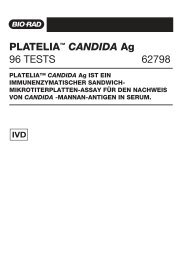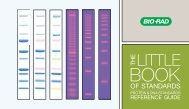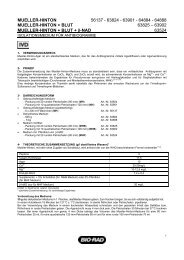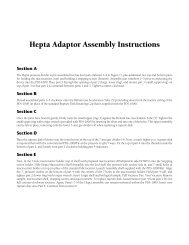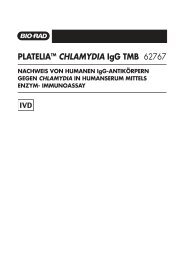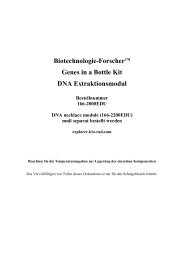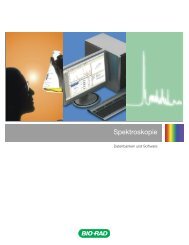Protein Expression and Purification Series - Bio-Rad
Protein Expression and Purification Series - Bio-Rad
Protein Expression and Purification Series - Bio-Rad
You also want an ePaper? Increase the reach of your titles
YUMPU automatically turns print PDFs into web optimized ePapers that Google loves.
CHAPTER 1<br />
BACKGROUND<br />
<strong>Protein</strong> <strong>Expression</strong> <strong>and</strong> <strong>Purification</strong> <strong>Series</strong><br />
to a shortage of thymidylates, interfering with nucleic acid synthesis. A lack of nucleic acid synthesis thus<br />
interferes with cell growth, proliferation, <strong>and</strong> ultimately causes cell death.<br />
DHFR Cancer Connection<br />
Cancer occurs when a particular cell loses the ability to control its division. These dividing cells spread,<br />
displace normal cells, disrupt the architecture of tissues, <strong>and</strong> use up the nutrients required by normal<br />
cells. Surgery can remove most of the cells in a solid tumor, but malignant cancers send out colonizing<br />
cells called metastases that use the blood <strong>and</strong> lymph systems to spread far from the tumor <strong>and</strong> non-solid<br />
tumors, such as leukemia or lymphoma, are not confined to one specific area. Clinicians use radiation or<br />
chemotherapy to kill these cells.<br />
Chemotherapy drugs target cancer cells by disrupting the functions of actively dividing cells. This strategy<br />
exploits the fact that most of the cells in an adult are not dividing. Therefore, chemotherapy damages the<br />
rapidly dividing cancer cells by disrupting structures required for mitosis, like spindle fibers, or by disrupting<br />
the production of nucleotides required for DNA replication. One of the first chemotherapeutic agents was<br />
methotrexate, a folic acid analog that interferes with folic acid metabolism. Treatment with methotrexate<br />
limits the ability of dividing cells to make nucleotides by competitively inhibiting the enzyme dihydrofolate<br />
reductase (DHFR). When the enzyme DHFR is inhibited, cancer cells cannot divide <strong>and</strong> spread.<br />
Occasionally after repeated treatments with methotrexate, a patient’s cancer will develop a methotrexate<br />
resistance <strong>and</strong> will stop responding to the drug. Some of these resistant cells when examined show that<br />
the resistance was due to an increased copy number of DHFR genes. This gene amplification leads to<br />
increased levels of DHFR protein in the cell <strong>and</strong> therefore an increased ability to catalyze its reaction <strong>and</strong><br />
produce nucleotides, even in the presence of methotrexate.<br />
DHFR <strong>and</strong> Malaria<br />
DHFR is also integral to parasite cell metabolism. Malaria is caused by the parasite Plasmodium falciparum,<br />
which is transmitted to humans by mosquitoes. Once in the human bloodstream, the parasite multiplies,<br />
eventually causing headaches, fever, coma, <strong>and</strong> ultimately, death if untreated.<br />
Like in humans, interrupting the DHFR pathway in Plasmodium leads to reduced DNA synthesis: blocking<br />
DHFR successfully blocks Plasmodium falciparum multiplication. There are many drugs to treat malaria, but<br />
drug-resistant strains are becoming more <strong>and</strong> more common. Strains resistant to the once effective DHFR<br />
inhibitors pyrimethamine, sulphadoxine, <strong>and</strong> methotrexate are appearing.<br />
Having a system to produce recombinant DHFR to study its enzymatic activity <strong>and</strong> develop inhibitors for<br />
chemotherapy or antimalarial drugs could be a powerful tool in developing new therapeutics. Scientists<br />
continue to search for effective drugs to stop the spread of malaria <strong>and</strong> cure those infected with malaria.<br />
(See Appendix J for a link to the World Health Organization’s site on malaria.)<br />
Use of DHFR in <strong>Bio</strong>manufacturing<br />
The regulation of the DHFR gene amplification phenomenon described above is used to produce<br />
genetically engineered CHO cells to biomanufacture particular therapeutic proteins. Cells containing the<br />
gene of interest <strong>and</strong> DHFR are treated with methotrexate leading to the amplification of the DHFR gene;<br />
since the gene of interest lies next to the DHFR gene, the transgene is amplified too. This increases the<br />
amount of protein produced by the cells. Individual clones are separated <strong>and</strong> independently tested for their<br />
ability to produce protein <strong>and</strong> to divide. A particular clone that produces a large amount of protein <strong>and</strong><br />
that retains its ability to divide quickly, will become the master cell bank from which all subsequent cells for<br />
production runs will be pulled.<br />
(For more information on biomanufacturing see Appendix G.)<br />
38 Chapter 1: Recombinant <strong>Protein</strong> <strong>Expression</strong> & <strong>Purification</strong>




